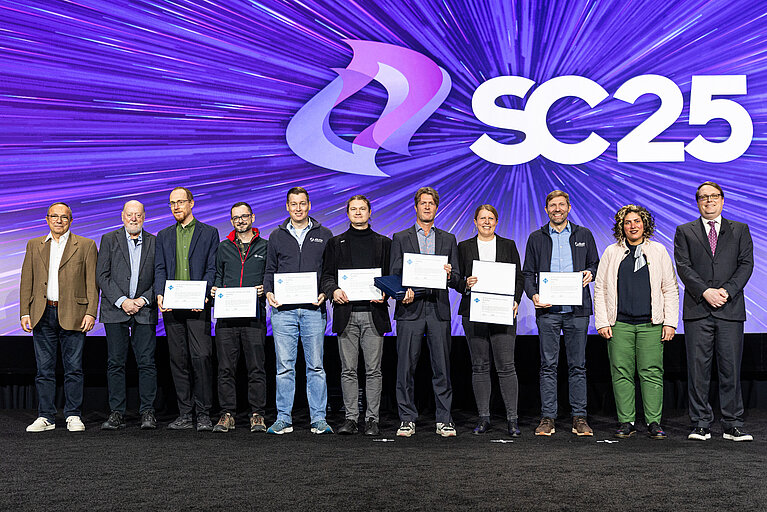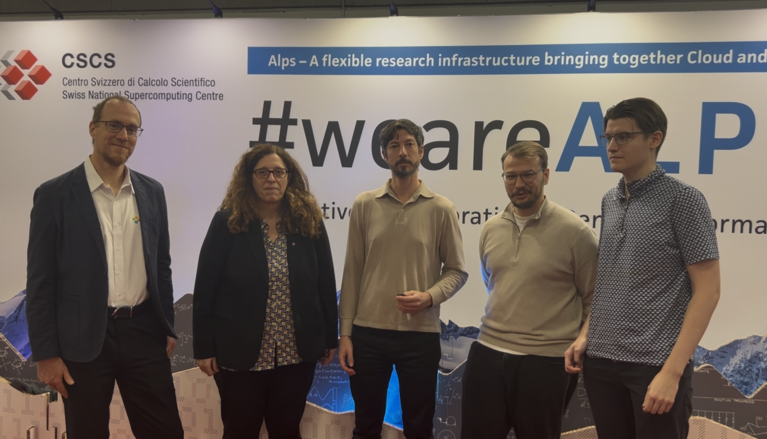November 24.11.2025 - by Maria Grazia Giuffreda
A Win for Climate Science: World’s First 1 km Global Climate Simulation
An international team of 26 scientists, including several from ETH Zurich and CSCS was awarded the 2025 ACM Gordon Bell Prize for Climate Modelling for achieving a long-sought goal in climate science: the first full Earth system simulation at 1 km resolution. Their project, “Computing the Full Earth System at 1 km Resolution,” represents a major leap in the realism and scientific value of global climate simulations. The prize recognizes transformative advances in parallel computing that address humanity’s most pressing environmental challenges. As climate change continues to intensify extreme weather, droughts, wildfires, and ecosystem disruption, the ability to model the entire Earth system at this level of detail opens new avenues for understanding and preparing for future climate risks.
A New Era in Global Climate Modelling
Climate models are among the most powerful tools for forecasting planetary change, yet capturing the full interaction of atmosphere, ocean, land, water, energy, and carbon cycles has remained largely out of reach. Traditional global models lacked the resolution to represent many local processes, forcing scientists to rely on regional models for finer-scale insights. The winning team overcame this limitation by conducting the first-ever global simulation at 1.25 km grid spacing, using an unprecedented number of degrees of freedom. This breakthrough was made possible by leveraging two of the world’s largest NVIDIA GH200 supercomputing installations: CSCS’s “Alps” system and the JSC JUPITER supercomputer. Together, they provided the computational scale and speed required to run this landmark simulation.
Technical Innovations Driving the Breakthrough
To achieve this resolution, the researchers introduced several advances in high-performance computing design. Their approach exploited functional parallelism to map different components of the Earth system onto heterogeneous architectures and decoupled the Fortran-based model implementation from architecture-specific optimizations, enabling performance portability and easier tuning across platforms.
These innovations not only unlocked the 1 km simulation but also pave the way for future global models that are faster, more adaptable, and more comprehensive.
Local Insights, Global Impact
The researchers emphasize that their achievement represents far more than a technical breakthrough. They explain that the new model has the potential to deliver global Earth system information at truly local scales, offering insights into how future warming will affect both people and ecosystems, information that has never before been available.
With this unprecedented level of detail, scientists can now study global processes with the same granularity once reserved for regional models, enabling more accurate predictions of extreme weather, localized climate impacts, and long-term planetary change.
A Pan-European Collaboration
This achievement reflects an exceptional collaboration across Europe’s leading climate science and HPC institutions.
The 26-member team brings together experts from ETH Zurich, including Torsten Hoefler, Alexandru Calotoiu, Yakup Budanaz, Pratyai Mazumder, Marcin Copik, and Benjamin Weber, working alongside researchers from the Swiss National Supercomputing Centre (CSCS), Jonathan Coles, Miguel Gila, and William Sawyer. From Germany, the effort was strengthened by contributions from the Max Planck Institute for Meteorology with Daniel Klocke, René Redler, Reiner Schnur, Helmuth Haak, Luis Kornblueh, Cathy Hohenegger, Nils Brüggemann, and Bjorn Stevens, from DKRZ with Jan Frederik Engels, Hendryk Bockelmann, and Claudia Frauen, as well as Dmitry Alexeev from NVIDIA, Fatemeh Chegini from the University of Hamburg and Manoel Römmer, Lars Hoffmann, Sabine Griessbach, Mathis Bode, and Andreas Herten from Forschungszentrum Jülich completing this highly interdisciplinary team.
Their combined expertise formed the foundation for achieving this landmark scientific breakthrough.
Honorable Mention for Quantum Transport Breakthrough
In addition to the main award, the ACM committee also recognized an outstanding ETH Zurich project with an Honorable Mention. A 10-member team led by Professor Mathieu Luisier was acknowledged for their work, “Ab-initio Quantum Transport with the GW Approximation, 42,240 Atoms, and Sustained Exascale Performance.” The team including Nicolas Vetsch, Alexandros Nikolaos Ziogas, Alexander Maeder, Vincent Maillou, Anders Winka, Jiang Cao, Grzegorz Kwasniewski, Leonard Deutschle (also with NVIDIA), Torsten Hoefler, and Mathieu Luisier achieved significant advances in large-scale quantum transport simulations.
Their work reached sustained exascale FP64 performance on some of the world’s most powerful supercomputers, marking a major step forward for computational materials science and demonstrating ETH Zurich’s continued leadership in HPC-driven research.
Recognition at SC25
The distinctions were announced at SC25 in St. Louis, Missouri, the world’s premier conference for high-performance computing. While the Gordon Bell Prize went to a US team and the work spans multiple leading U.S. supercomputers, it also showcases the unique strength of CSCS’s “Alps” supercomputer. Together, these achievements highlight the central role of ETH Zurich, CSCS, and the “Alps” supercomputer in driving forward the global frontiers of scientific computing.
References:
- https://www.cscs.ch/science/computer-science-hpc/2025/eth-zuerich-team-simulates-a-full-nanoribbon-transistor-and-earns-a-gordon-bell-prize-nomination
- https://www.cscs.ch/science/computer-science-hpc/2025/global-climate-simulations-achieve-125-km-resolution-team-nominated-for-climate-gordon-bell-prize

